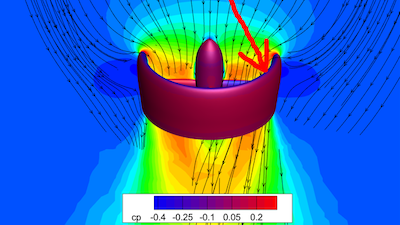Imagine a world where aircraft rise vertically from a helipad, transition seamlessly into high-speed forward flight, travel several hundred miles, and then land gently on a small patch of grass, a rooftop, or a parking lot. This isn’t a far-off dream—it’s the promise of XTI Aerospace’s TriFan 600, a game-changing xVTOL airplane. One of aviation’s most intricate engineering challenges lies at the core of this innovation: designing a ducted fan system that provides an efficient vertical lift for takeoff and landing while also transitioning to the high-speed performance required for cruising flight.
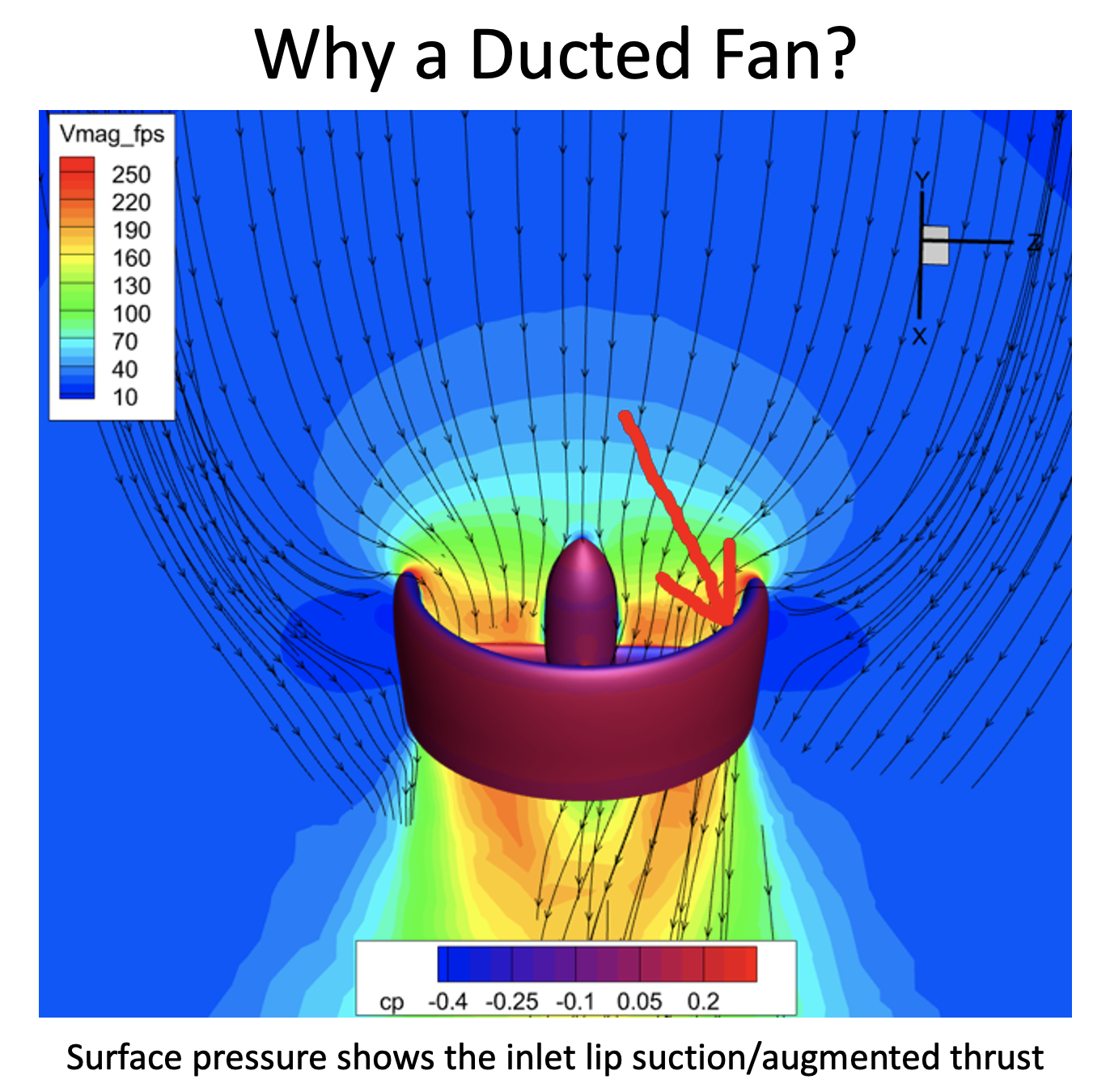 Ducted fans are circular, shrouded propulsion units containing multiple rotating blades. These fans generate the vertical thrust necessary for takeoff and landing, enabling the aircraft to operate in locations without the need for a runway. However, they must also transition smoothly onto wing-borne flight, where the aircraft’s forward motion generates lift from the wing, allowing the ducted fans to reduce power. This dual functionality creates a unique set of engineering challenges, as the aerodynamic demands of vertical lift differ significantly from those of high-speed forward flight.
Ducted fans are circular, shrouded propulsion units containing multiple rotating blades. These fans generate the vertical thrust necessary for takeoff and landing, enabling the aircraft to operate in locations without the need for a runway. However, they must also transition smoothly onto wing-borne flight, where the aircraft’s forward motion generates lift from the wing, allowing the ducted fans to reduce power. This dual functionality creates a unique set of engineering challenges, as the aerodynamic demands of vertical lift differ significantly from those of high-speed forward flight.
In this article, we’ll explore the problem-solving ingenuity behind the TriFan 600’s ducted fan design and how XTI is turning the promise of point-to-point air travel into reality.
The Role of Ducted Fans in Vertical Lift Aircraft
Ducted fans are a cornerstone of advanced air mobility. Unlike traditional helicopter rotors or open propellers, ducted fans offer several advantages:
- Precision and Control: They allow for smooth, controlled vertical takeoffs and landings, which are critical for operations in constrained spaces like urban rooftops or remote landing zones.
- Efficiency at Takeoff: The shroud reduces blade-tip losses, improving thrust efficiency during vertical lift.
- Safety: The enclosed design minimizes the risk of blade contact with people or objects, making them ideal for operations in populated areas and helps prevent damage to the propeller blades.
- Noise Reduction: The shroud reduces noise output compared to open rotors, a crucial factor for urban acceptance.
- Augmented Thrust: The duct propeller drives airflow around the leading edge of the duct which in turn generates lift much like a wing does. This “augmented thrust” is in addition to the thrust the propellers are generating. The augmented thrust plus propeller thrust allows a ducted fan system to have a smaller diameter than an open rotor or propeller for the same horsepower.
The ducted fans on the TriFan 600 are designed to lift the aircraft from a stationary position, carry it into flight, and then seamlessly transition to the wings for forward propulsion. But making a single propulsion system excel in such varied roles requires creative problem-solving.
Engineering Challenges: From Vertical Lift to Wing-Borne Flight
The dual-mode operation of the TriFan 600’s ducted fans presents several key engineering challenges:
1. Efficient Vertical Lift for Takeoff
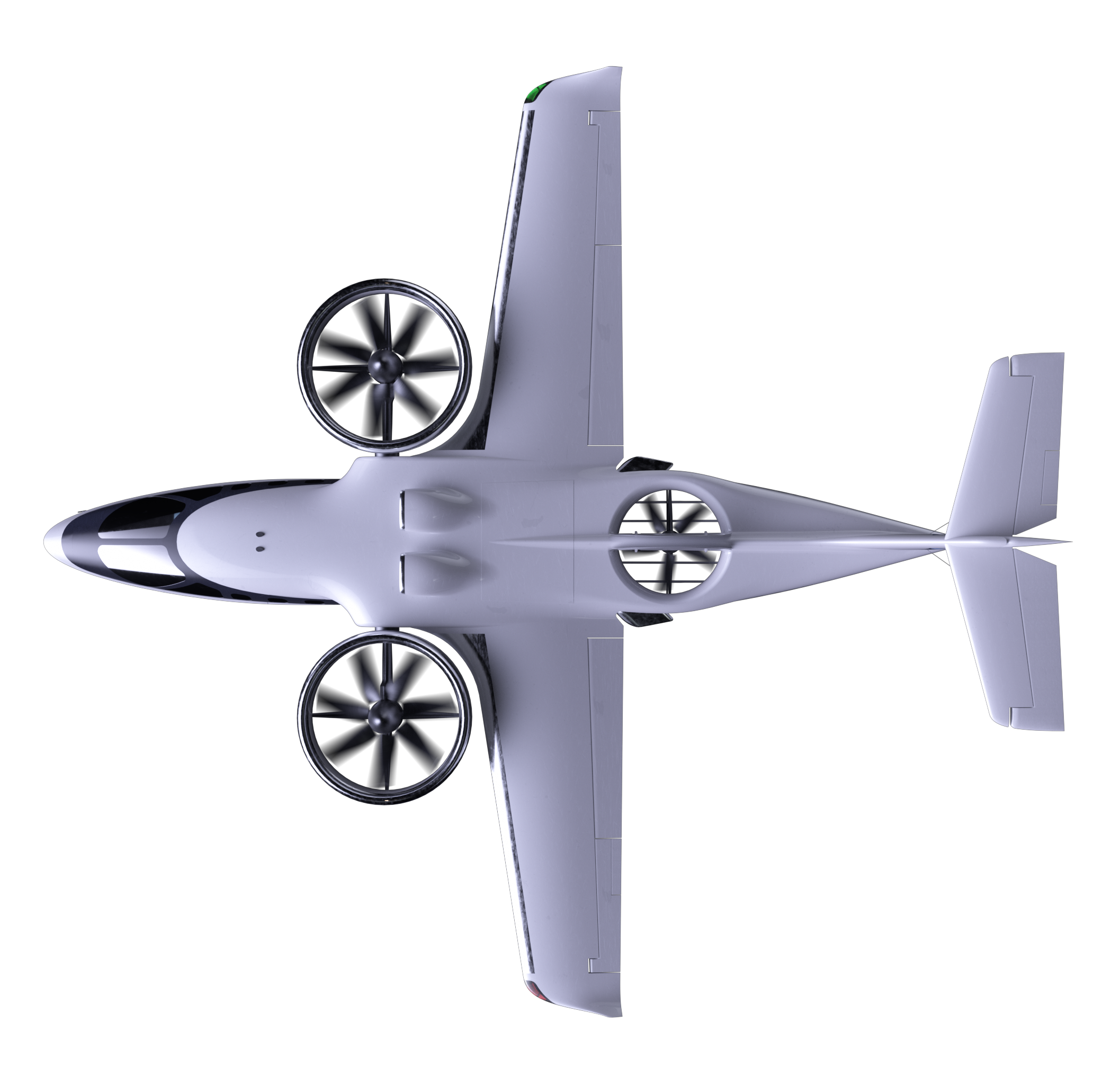 The ducted fans must generate enough thrust during vertical takeoff to lift the aircraft’s full weight with enough control and maneuvering margin. This requires careful aerodynamic shaping of the duct to maximize airflow and minimize energy loss. Engineers at XTI use advanced computational fluid dynamics (CFD) simulations to optimize the duct shape, ensuring it provides maximum thrust efficiency during takeoff and landing.
The ducted fans must generate enough thrust during vertical takeoff to lift the aircraft’s full weight with enough control and maneuvering margin. This requires careful aerodynamic shaping of the duct to maximize airflow and minimize energy loss. Engineers at XTI use advanced computational fluid dynamics (CFD) simulations to optimize the duct shape, ensuring it provides maximum thrust efficiency during takeoff and landing.
The design must also account for rapid deceleration and controlled descent during landing. Balancing these requirements involves refining the fan blade angles, shroud geometry, and intake configurations to deliver precise performance.
2. Smooth Transition to Wing-Borne Flight
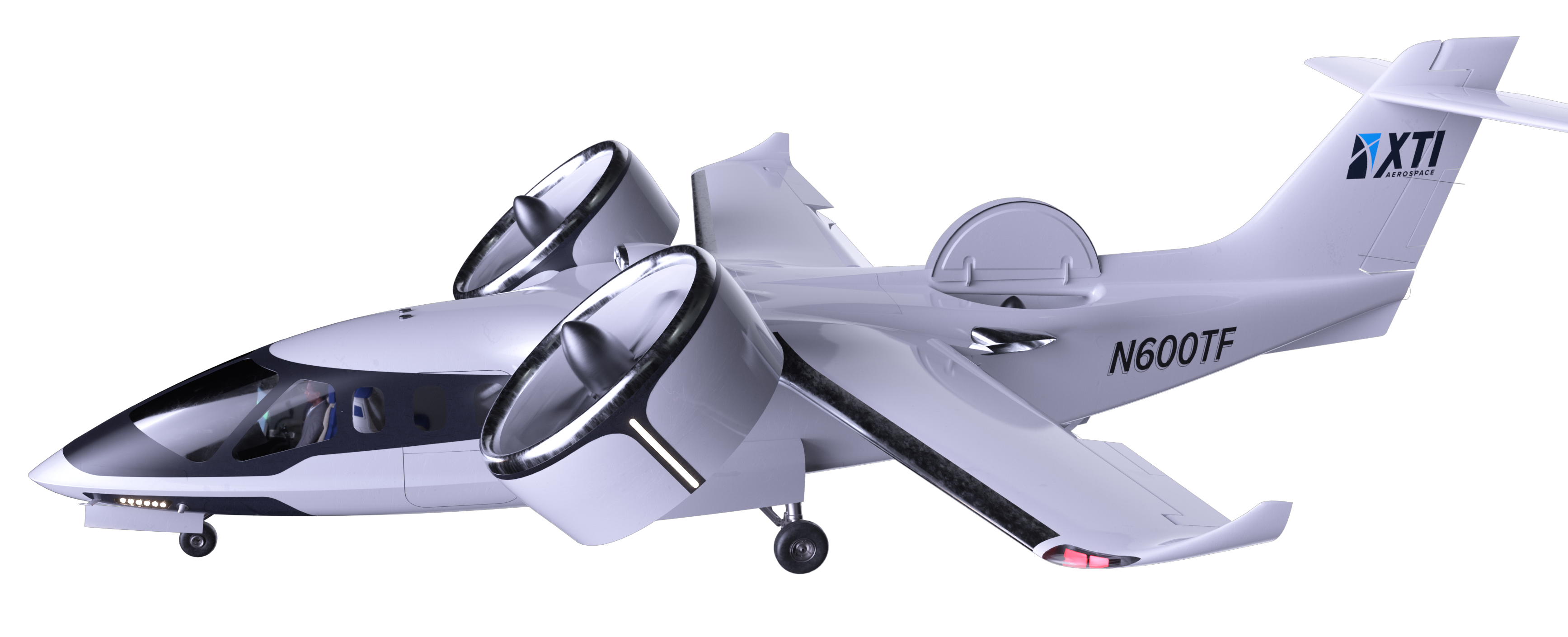 Once airborne, the TriFan 600 transitions from vertical lift to wing-borne flight. This shift requires the ducted fans to reduce their thrust output as the wings take over the role of providing lift. This transition must be seamless to avoid loss of stability or control.
Once airborne, the TriFan 600 transitions from vertical lift to wing-borne flight. This shift requires the ducted fans to reduce their thrust output as the wings take over the role of providing lift. This transition must be seamless to avoid loss of stability or control.
XTI engineers are tackling this challenge with the following:
- Control Algorithms: Sophisticated software manages the power reduction and airflow redirection during the transition phase.
- Duct Aerodynamics: The duct’s shape minimizes drag as the fans reduce thrust for cruise flight, maintaining aerodynamic efficiency as the wings generate increasing lift.
- Unified Flight Control: The TriFan 600 implements unified flight control (UFC) similar to the Lockheed Martin F-35B. UFC is based on the premise that the transition between thrust-borne and wing-borne flight should be intuitive to the pilot and that the axis of control associated with a given inceptor should remain the same in both flight regimes.
3. Drag Reduction for High-Speed Cruise
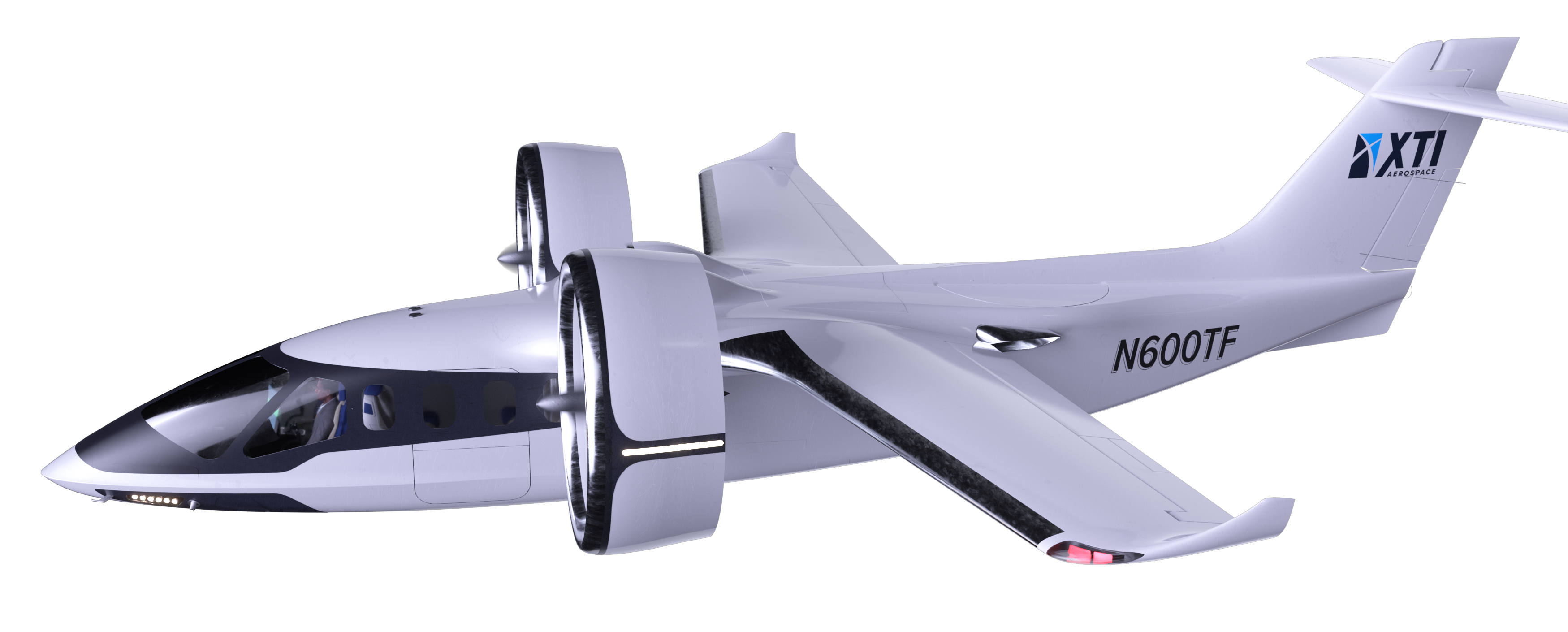 In this phase, the ducted fans are no longer the primary lift generators during forward flight. However, their presence still impacts the aircraft’s aerodynamics. To achieve optimal speed, designers are engineering ducts that enhance airflow and reduce drag. XTI’s design includes aerodynamic fairings and optimized fan blade geometries that minimize resistance, allowing the TriFan 600 to reach speeds up to 345 mph without compromising efficiency.
In this phase, the ducted fans are no longer the primary lift generators during forward flight. However, their presence still impacts the aircraft’s aerodynamics. To achieve optimal speed, designers are engineering ducts that enhance airflow and reduce drag. XTI’s design includes aerodynamic fairings and optimized fan blade geometries that minimize resistance, allowing the TriFan 600 to reach speeds up to 345 mph without compromising efficiency.
Adapting for Real-World Applications
The TriFan 600 is on track for a preliminary design review in 2025. It’s being built for real-world missions, from business travel to air medical transport. This means the ducted fan system must deliver consistent performance under varying payloads, altitudes, and weather conditions.
For example:
- In air medical missions, the fans must lift the aircraft, medical equipment, and passengers, then transition quickly to cruise mode to reach the destination as fast as possible.
- The system must provide a comfortable, quiet experience in business aviation, reducing noise levels during takeoff and landing.
The TriFan 600 is engineered to operate in challenging environments. Advanced noise-reduction techniques built into the ducted fans ensure the aircraft can operate in urban areas with minimal disruption. Additionally, the system must be resilient in adverse weather, such as icing conditions, which could impact flight stability. With cutting-edge materials and systems incorporated into the design, the TriFan 600 is ready to perform safely in various environmental conditions.
XTI’s Solutions: Engineering Innovation in Action
Hybrid Propulsion for Sustainability
The TriFan 600 is powered by twin turboshaft engines that are capable of burning 100% sustainable aviation fuel (SAF). The propulsion system can transition to hybrid-electric or fully electric power as those technologies mature. This adaptability supports sustainability goals and ensures that the ducted fans remain effective under evolving propulsion requirements.
Noise Optimization
XTI’s engineers use advanced materials and computational models to reduce fan noise. This is essential for gaining regulatory approval and public acceptance, particularly for operations in urban areas. The team aims to achieve noise levels far below those of traditional helicopters by optimizing blade shapes, shroud geometry, and fan speeds.
Why It Matters: The Impact of the TriFan 600
The TriFan 600 isn’t just an aircraft—it’s a new aviation category. Its ducted fan system unlocks capabilities that traditional aircraft cannot match:
- Point-to-Point Travel: Skip the airport and fly directly from a helipad in the city to your destination.
- Flexibility: Operate in diverse environments, from urban rooftops to remote fields.
- Sustainability: Reduce emissions today with SAF and move toward greener propulsion in the future.
By overcoming the challenges of vertical lift and wing-borne flight, XTI is creating a solution that can serve diverse industries like business travel, medical transport, and disaster response, all while delivering speed, efficiency, and convenience. With the ability to achieve speeds of up to 345 mph and a range of 700 miles, the TriFan 600 represents the future of aviation.
Conclusion
The ducted fan is more than a technological marvel—it’s the key to unlocking the future of air mobility. With the TriFan 600, XTI Aerospace is proving that vertical lift and forward flight challenges can be solved with innovation, precision, and a commitment to excellence.
As the TriFan 600 takes flight, it’s setting the standard for what’s possible in advanced air mobility. How will these innovations transform travel, business, and emergency response? The journey is just beginning, and XTI is leading the way.
Let’s take flight into a future of more innovative, faster, and more sustainable air travel. Join XTI in redefining what’s possible.
Author: John Ramstead, CPLC, ACC

